Mental Health Assessment and Intervention Report: Andy's Case Study
VerifiedAdded on 2023/06/10
|10
|2243
|361
Report
AI Summary
This report presents a comprehensive mental health assessment and intervention plan for Andy, a 21-year-old patient exhibiting signs of mental illness. The assessment, based on a case study, details Andy's history, mental state examination, and risk assessment, leading to a provisional diagnosis of schizophrenia. The report utilizes the DSM-5 criteria to support the diagnosis, highlighting symptoms such as auditory and somatic hallucinations, delusions, and thought insertion. Furthermore, the report outlines a detailed care plan, including medical interventions with antipsychotic drugs, psychosocial interventions like cognitive behavior therapy and psychoeducation, and nursing interventions focusing on therapeutic relationships and patient support. The report emphasizes the importance of a holistic approach to patient care, considering both medical and psychosocial aspects to improve Andy's well-being. The student has provided a comprehensive evaluation and care strategy for the patient.
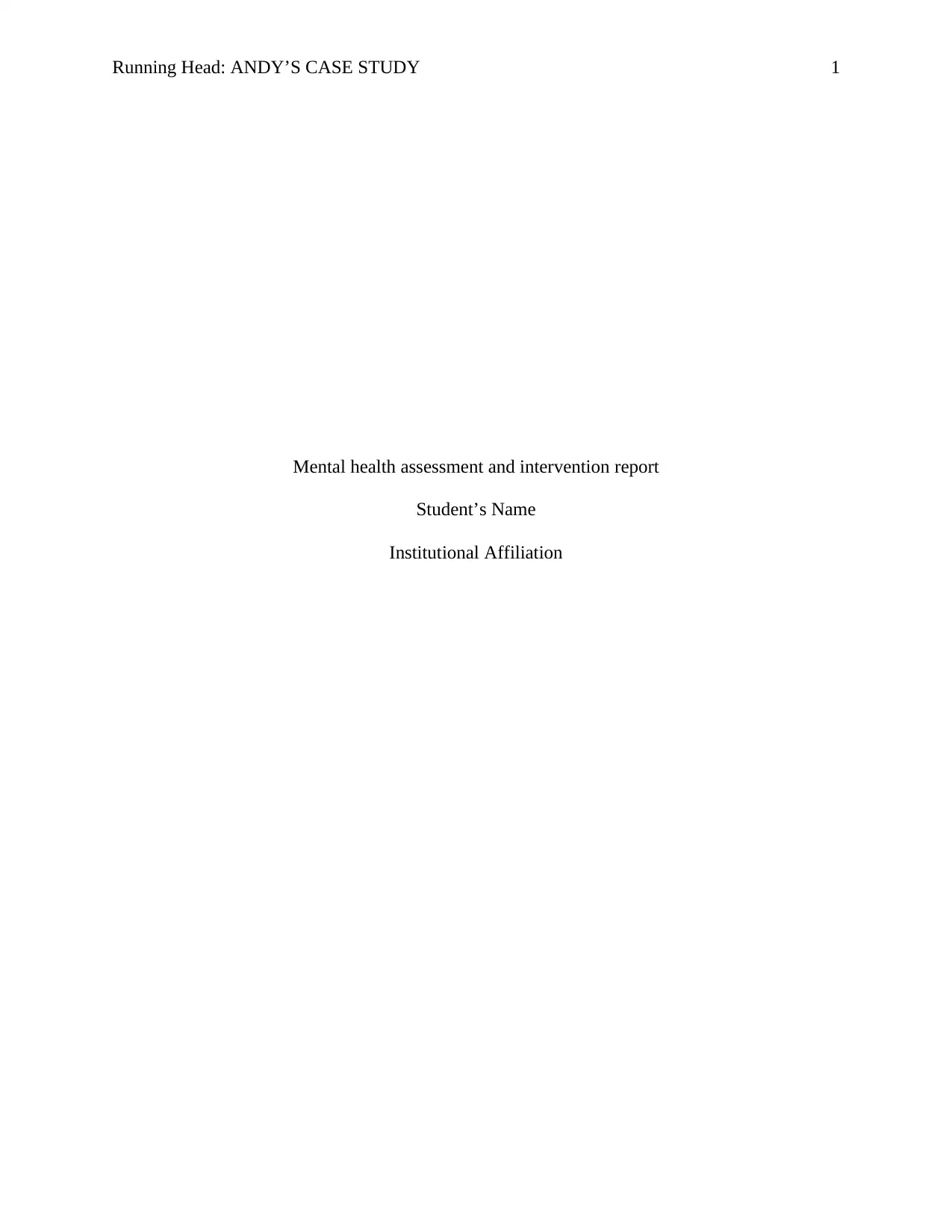
Running Head: ANDY’S CASE STUDY 1
Mental health assessment and intervention report
Student’s Name
Institutional Affiliation
Mental health assessment and intervention report
Student’s Name
Institutional Affiliation
Paraphrase This Document
Need a fresh take? Get an instant paraphrase of this document with our AI Paraphraser
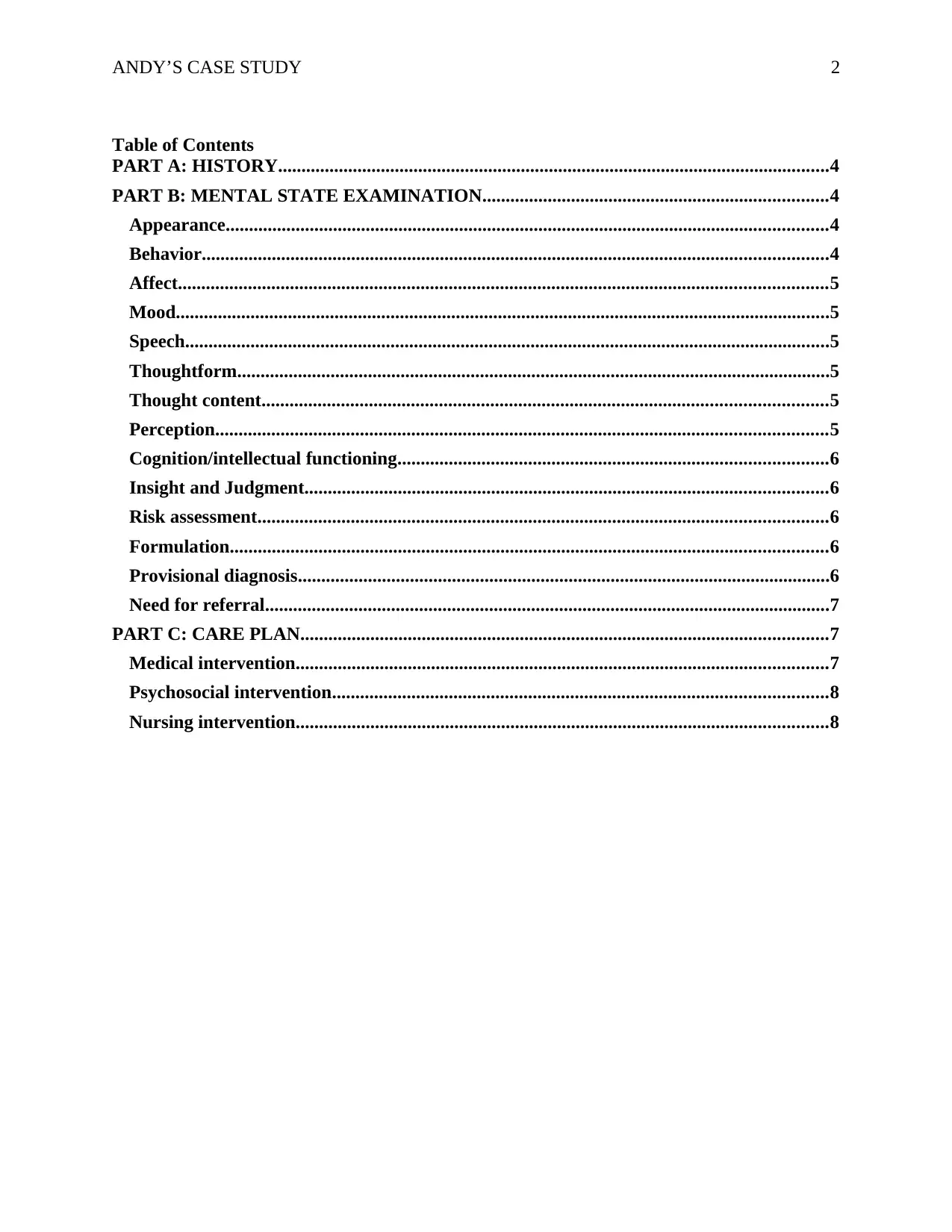
ANDY’S CASE STUDY 2
Table of Contents
PART A: HISTORY......................................................................................................................4
PART B: MENTAL STATE EXAMINATION..........................................................................4
Appearance.................................................................................................................................4
Behavior......................................................................................................................................4
Affect...........................................................................................................................................5
Mood............................................................................................................................................5
Speech..........................................................................................................................................5
Thoughtform...............................................................................................................................5
Thought content.........................................................................................................................5
Perception...................................................................................................................................5
Cognition/intellectual functioning............................................................................................6
Insight and Judgment................................................................................................................6
Risk assessment..........................................................................................................................6
Formulation................................................................................................................................6
Provisional diagnosis..................................................................................................................6
Need for referral.........................................................................................................................7
PART C: CARE PLAN.................................................................................................................7
Medical intervention..................................................................................................................7
Psychosocial intervention..........................................................................................................8
Nursing intervention..................................................................................................................8
Table of Contents
PART A: HISTORY......................................................................................................................4
PART B: MENTAL STATE EXAMINATION..........................................................................4
Appearance.................................................................................................................................4
Behavior......................................................................................................................................4
Affect...........................................................................................................................................5
Mood............................................................................................................................................5
Speech..........................................................................................................................................5
Thoughtform...............................................................................................................................5
Thought content.........................................................................................................................5
Perception...................................................................................................................................5
Cognition/intellectual functioning............................................................................................6
Insight and Judgment................................................................................................................6
Risk assessment..........................................................................................................................6
Formulation................................................................................................................................6
Provisional diagnosis..................................................................................................................6
Need for referral.........................................................................................................................7
PART C: CARE PLAN.................................................................................................................7
Medical intervention..................................................................................................................7
Psychosocial intervention..........................................................................................................8
Nursing intervention..................................................................................................................8
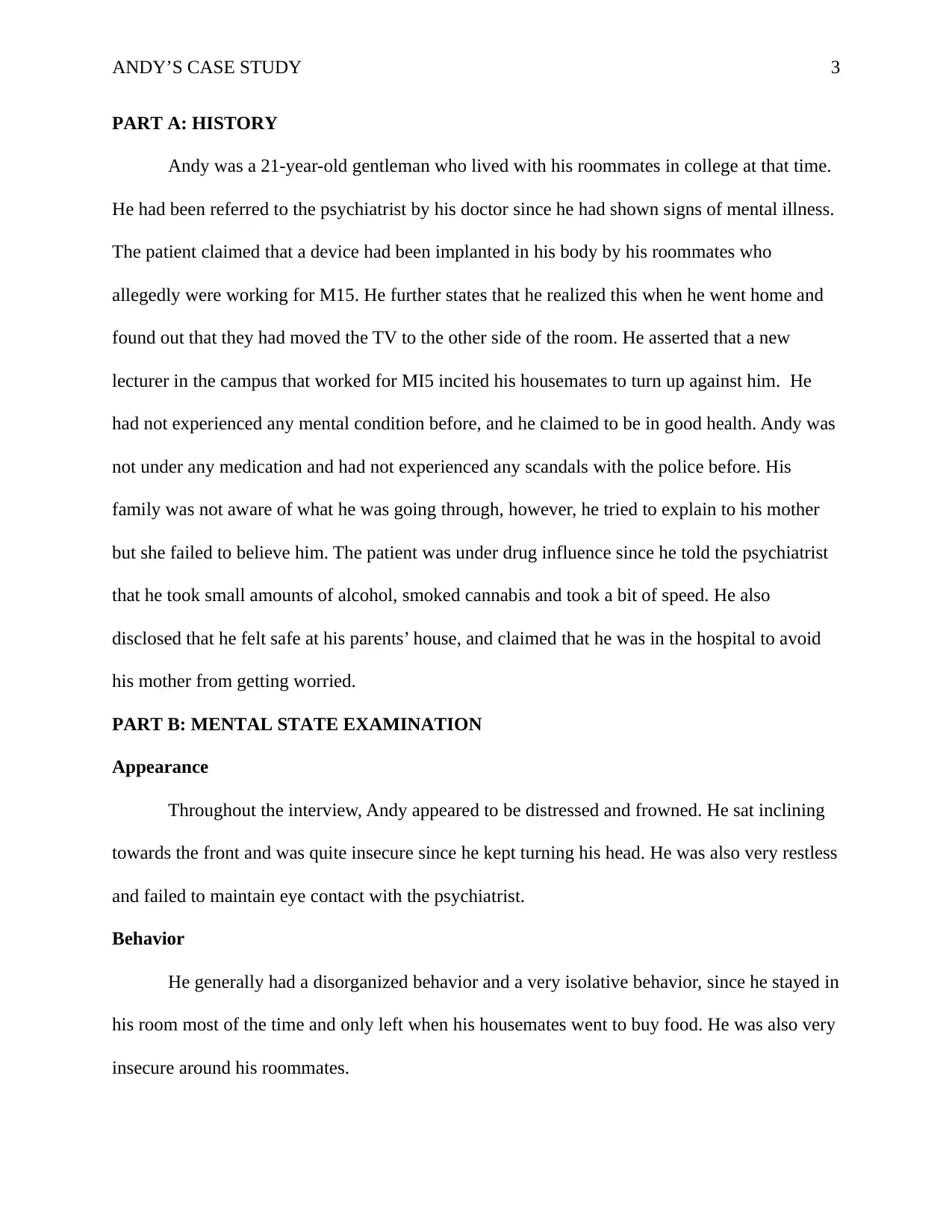
ANDY’S CASE STUDY 3
PART A: HISTORY
Andy was a 21-year-old gentleman who lived with his roommates in college at that time.
He had been referred to the psychiatrist by his doctor since he had shown signs of mental illness.
The patient claimed that a device had been implanted in his body by his roommates who
allegedly were working for M15. He further states that he realized this when he went home and
found out that they had moved the TV to the other side of the room. He asserted that a new
lecturer in the campus that worked for MI5 incited his housemates to turn up against him. He
had not experienced any mental condition before, and he claimed to be in good health. Andy was
not under any medication and had not experienced any scandals with the police before. His
family was not aware of what he was going through, however, he tried to explain to his mother
but she failed to believe him. The patient was under drug influence since he told the psychiatrist
that he took small amounts of alcohol, smoked cannabis and took a bit of speed. He also
disclosed that he felt safe at his parents’ house, and claimed that he was in the hospital to avoid
his mother from getting worried.
PART B: MENTAL STATE EXAMINATION
Appearance
Throughout the interview, Andy appeared to be distressed and frowned. He sat inclining
towards the front and was quite insecure since he kept turning his head. He was also very restless
and failed to maintain eye contact with the psychiatrist.
Behavior
He generally had a disorganized behavior and a very isolative behavior, since he stayed in
his room most of the time and only left when his housemates went to buy food. He was also very
insecure around his roommates.
PART A: HISTORY
Andy was a 21-year-old gentleman who lived with his roommates in college at that time.
He had been referred to the psychiatrist by his doctor since he had shown signs of mental illness.
The patient claimed that a device had been implanted in his body by his roommates who
allegedly were working for M15. He further states that he realized this when he went home and
found out that they had moved the TV to the other side of the room. He asserted that a new
lecturer in the campus that worked for MI5 incited his housemates to turn up against him. He
had not experienced any mental condition before, and he claimed to be in good health. Andy was
not under any medication and had not experienced any scandals with the police before. His
family was not aware of what he was going through, however, he tried to explain to his mother
but she failed to believe him. The patient was under drug influence since he told the psychiatrist
that he took small amounts of alcohol, smoked cannabis and took a bit of speed. He also
disclosed that he felt safe at his parents’ house, and claimed that he was in the hospital to avoid
his mother from getting worried.
PART B: MENTAL STATE EXAMINATION
Appearance
Throughout the interview, Andy appeared to be distressed and frowned. He sat inclining
towards the front and was quite insecure since he kept turning his head. He was also very restless
and failed to maintain eye contact with the psychiatrist.
Behavior
He generally had a disorganized behavior and a very isolative behavior, since he stayed in
his room most of the time and only left when his housemates went to buy food. He was also very
insecure around his roommates.
⊘ This is a preview!⊘
Do you want full access?
Subscribe today to unlock all pages.

Trusted by 1+ million students worldwide
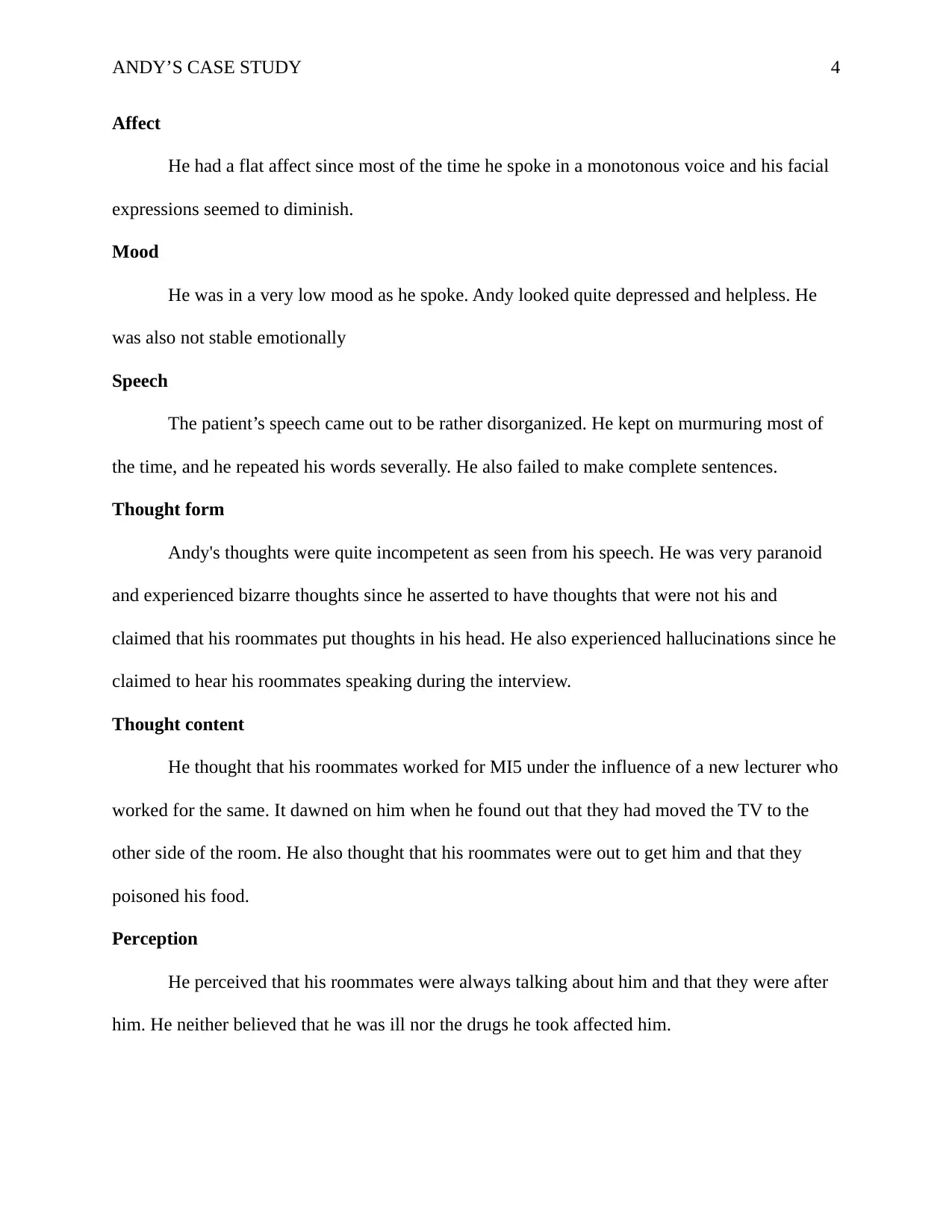
ANDY’S CASE STUDY 4
Affect
He had a flat affect since most of the time he spoke in a monotonous voice and his facial
expressions seemed to diminish.
Mood
He was in a very low mood as he spoke. Andy looked quite depressed and helpless. He
was also not stable emotionally
Speech
The patient’s speech came out to be rather disorganized. He kept on murmuring most of
the time, and he repeated his words severally. He also failed to make complete sentences.
Thought form
Andy's thoughts were quite incompetent as seen from his speech. He was very paranoid
and experienced bizarre thoughts since he asserted to have thoughts that were not his and
claimed that his roommates put thoughts in his head. He also experienced hallucinations since he
claimed to hear his roommates speaking during the interview.
Thought content
He thought that his roommates worked for MI5 under the influence of a new lecturer who
worked for the same. It dawned on him when he found out that they had moved the TV to the
other side of the room. He also thought that his roommates were out to get him and that they
poisoned his food.
Perception
He perceived that his roommates were always talking about him and that they were after
him. He neither believed that he was ill nor the drugs he took affected him.
Affect
He had a flat affect since most of the time he spoke in a monotonous voice and his facial
expressions seemed to diminish.
Mood
He was in a very low mood as he spoke. Andy looked quite depressed and helpless. He
was also not stable emotionally
Speech
The patient’s speech came out to be rather disorganized. He kept on murmuring most of
the time, and he repeated his words severally. He also failed to make complete sentences.
Thought form
Andy's thoughts were quite incompetent as seen from his speech. He was very paranoid
and experienced bizarre thoughts since he asserted to have thoughts that were not his and
claimed that his roommates put thoughts in his head. He also experienced hallucinations since he
claimed to hear his roommates speaking during the interview.
Thought content
He thought that his roommates worked for MI5 under the influence of a new lecturer who
worked for the same. It dawned on him when he found out that they had moved the TV to the
other side of the room. He also thought that his roommates were out to get him and that they
poisoned his food.
Perception
He perceived that his roommates were always talking about him and that they were after
him. He neither believed that he was ill nor the drugs he took affected him.
Paraphrase This Document
Need a fresh take? Get an instant paraphrase of this document with our AI Paraphraser
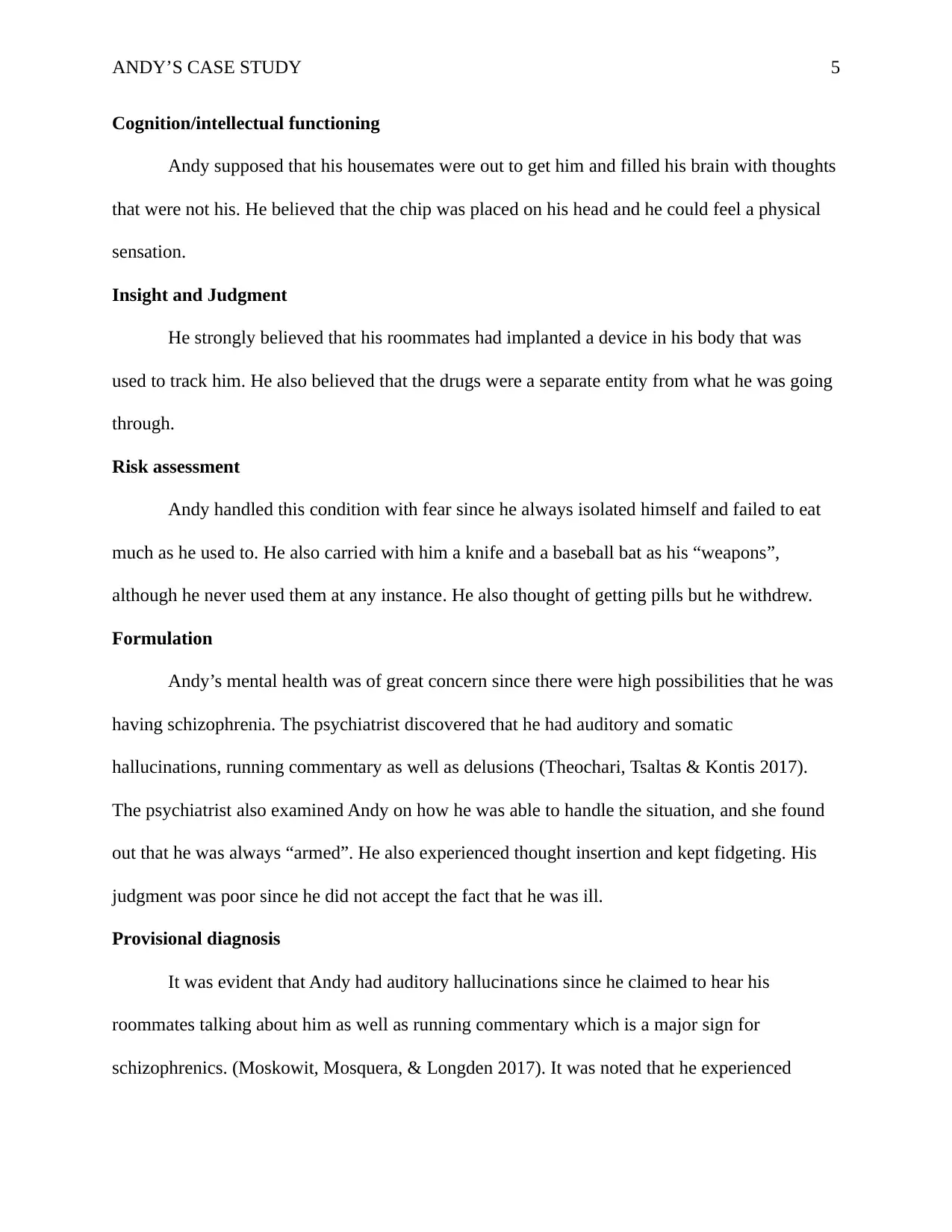
ANDY’S CASE STUDY 5
Cognition/intellectual functioning
Andy supposed that his housemates were out to get him and filled his brain with thoughts
that were not his. He believed that the chip was placed on his head and he could feel a physical
sensation.
Insight and Judgment
He strongly believed that his roommates had implanted a device in his body that was
used to track him. He also believed that the drugs were a separate entity from what he was going
through.
Risk assessment
Andy handled this condition with fear since he always isolated himself and failed to eat
much as he used to. He also carried with him a knife and a baseball bat as his “weapons”,
although he never used them at any instance. He also thought of getting pills but he withdrew.
Formulation
Andy’s mental health was of great concern since there were high possibilities that he was
having schizophrenia. The psychiatrist discovered that he had auditory and somatic
hallucinations, running commentary as well as delusions (Theochari, Tsaltas & Kontis 2017).
The psychiatrist also examined Andy on how he was able to handle the situation, and she found
out that he was always “armed”. He also experienced thought insertion and kept fidgeting. His
judgment was poor since he did not accept the fact that he was ill.
Provisional diagnosis
It was evident that Andy had auditory hallucinations since he claimed to hear his
roommates talking about him as well as running commentary which is a major sign for
schizophrenics. (Moskowit, Mosquera, & Longden 2017). It was noted that he experienced
Cognition/intellectual functioning
Andy supposed that his housemates were out to get him and filled his brain with thoughts
that were not his. He believed that the chip was placed on his head and he could feel a physical
sensation.
Insight and Judgment
He strongly believed that his roommates had implanted a device in his body that was
used to track him. He also believed that the drugs were a separate entity from what he was going
through.
Risk assessment
Andy handled this condition with fear since he always isolated himself and failed to eat
much as he used to. He also carried with him a knife and a baseball bat as his “weapons”,
although he never used them at any instance. He also thought of getting pills but he withdrew.
Formulation
Andy’s mental health was of great concern since there were high possibilities that he was
having schizophrenia. The psychiatrist discovered that he had auditory and somatic
hallucinations, running commentary as well as delusions (Theochari, Tsaltas & Kontis 2017).
The psychiatrist also examined Andy on how he was able to handle the situation, and she found
out that he was always “armed”. He also experienced thought insertion and kept fidgeting. His
judgment was poor since he did not accept the fact that he was ill.
Provisional diagnosis
It was evident that Andy had auditory hallucinations since he claimed to hear his
roommates talking about him as well as running commentary which is a major sign for
schizophrenics. (Moskowit, Mosquera, & Longden 2017). It was noted that he experienced
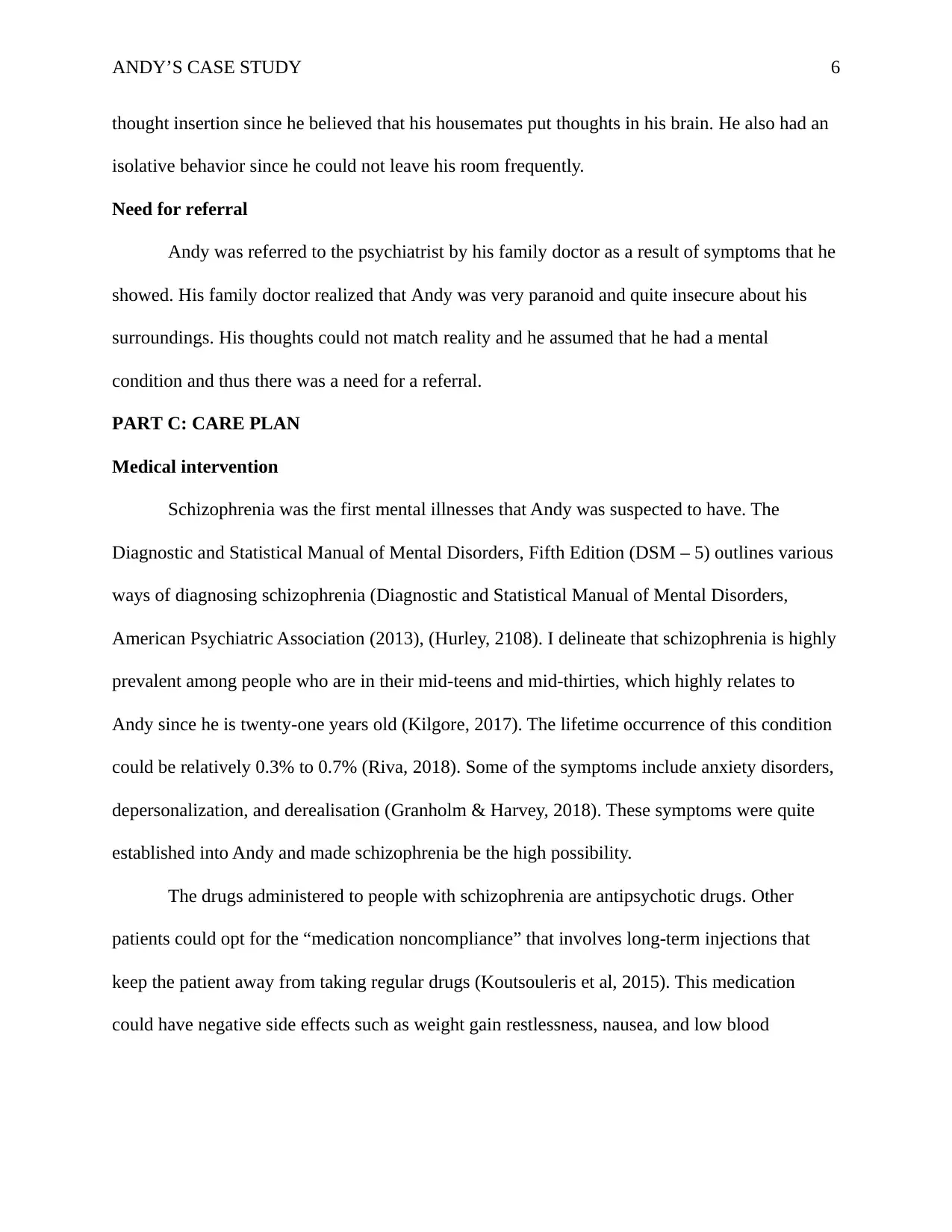
ANDY’S CASE STUDY 6
thought insertion since he believed that his housemates put thoughts in his brain. He also had an
isolative behavior since he could not leave his room frequently.
Need for referral
Andy was referred to the psychiatrist by his family doctor as a result of symptoms that he
showed. His family doctor realized that Andy was very paranoid and quite insecure about his
surroundings. His thoughts could not match reality and he assumed that he had a mental
condition and thus there was a need for a referral.
PART C: CARE PLAN
Medical intervention
Schizophrenia was the first mental illnesses that Andy was suspected to have. The
Diagnostic and Statistical Manual of Mental Disorders, Fifth Edition (DSM – 5) outlines various
ways of diagnosing schizophrenia (Diagnostic and Statistical Manual of Mental Disorders,
American Psychiatric Association (2013), (Hurley, 2108). I delineate that schizophrenia is highly
prevalent among people who are in their mid-teens and mid-thirties, which highly relates to
Andy since he is twenty-one years old (Kilgore, 2017). The lifetime occurrence of this condition
could be relatively 0.3% to 0.7% (Riva, 2018). Some of the symptoms include anxiety disorders,
depersonalization, and derealisation (Granholm & Harvey, 2018). These symptoms were quite
established into Andy and made schizophrenia be the high possibility.
The drugs administered to people with schizophrenia are antipsychotic drugs. Other
patients could opt for the “medication noncompliance” that involves long-term injections that
keep the patient away from taking regular drugs (Koutsouleris et al, 2015). This medication
could have negative side effects such as weight gain restlessness, nausea, and low blood
thought insertion since he believed that his housemates put thoughts in his brain. He also had an
isolative behavior since he could not leave his room frequently.
Need for referral
Andy was referred to the psychiatrist by his family doctor as a result of symptoms that he
showed. His family doctor realized that Andy was very paranoid and quite insecure about his
surroundings. His thoughts could not match reality and he assumed that he had a mental
condition and thus there was a need for a referral.
PART C: CARE PLAN
Medical intervention
Schizophrenia was the first mental illnesses that Andy was suspected to have. The
Diagnostic and Statistical Manual of Mental Disorders, Fifth Edition (DSM – 5) outlines various
ways of diagnosing schizophrenia (Diagnostic and Statistical Manual of Mental Disorders,
American Psychiatric Association (2013), (Hurley, 2108). I delineate that schizophrenia is highly
prevalent among people who are in their mid-teens and mid-thirties, which highly relates to
Andy since he is twenty-one years old (Kilgore, 2017). The lifetime occurrence of this condition
could be relatively 0.3% to 0.7% (Riva, 2018). Some of the symptoms include anxiety disorders,
depersonalization, and derealisation (Granholm & Harvey, 2018). These symptoms were quite
established into Andy and made schizophrenia be the high possibility.
The drugs administered to people with schizophrenia are antipsychotic drugs. Other
patients could opt for the “medication noncompliance” that involves long-term injections that
keep the patient away from taking regular drugs (Koutsouleris et al, 2015). This medication
could have negative side effects such as weight gain restlessness, nausea, and low blood
⊘ This is a preview!⊘
Do you want full access?
Subscribe today to unlock all pages.

Trusted by 1+ million students worldwide
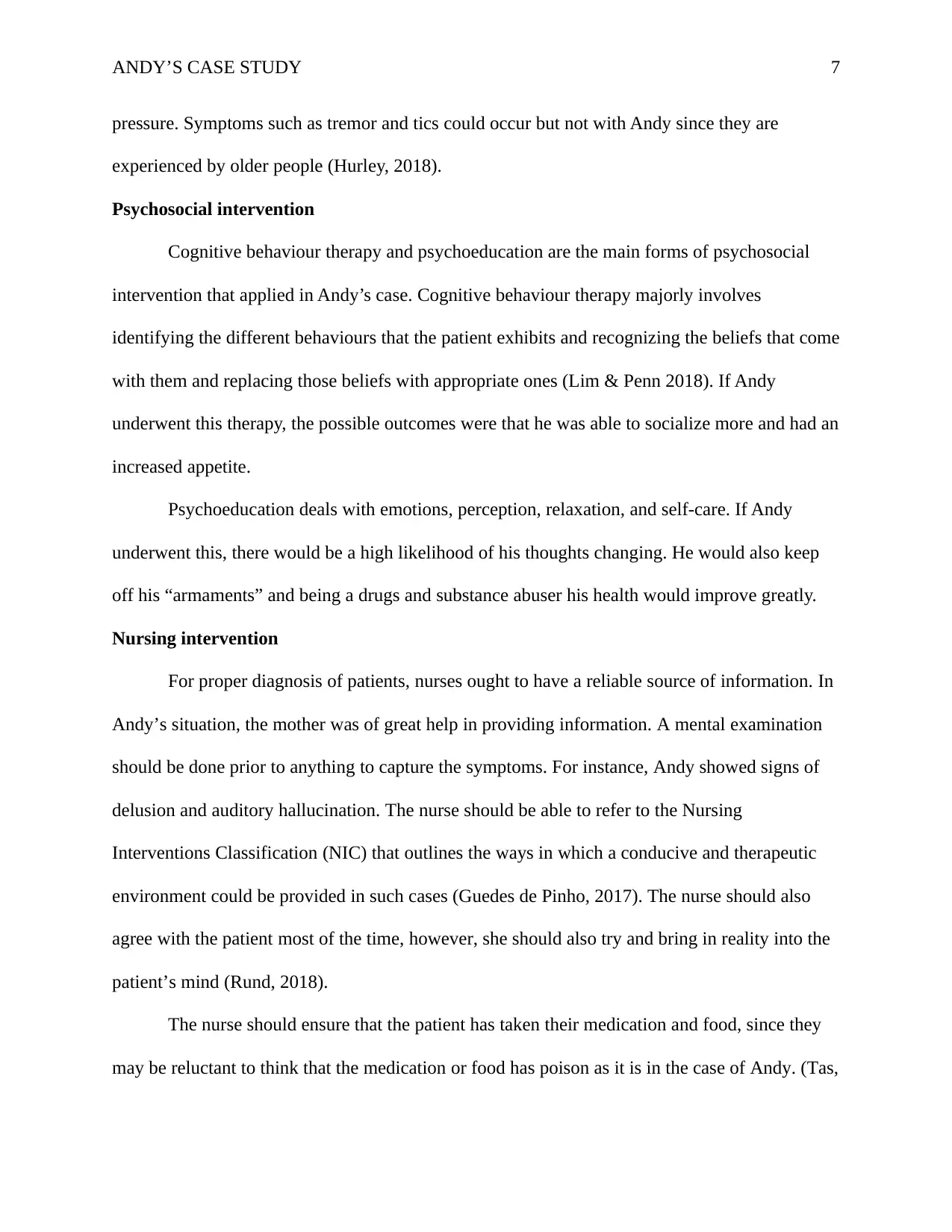
ANDY’S CASE STUDY 7
pressure. Symptoms such as tremor and tics could occur but not with Andy since they are
experienced by older people (Hurley, 2018).
Psychosocial intervention
Cognitive behaviour therapy and psychoeducation are the main forms of psychosocial
intervention that applied in Andy’s case. Cognitive behaviour therapy majorly involves
identifying the different behaviours that the patient exhibits and recognizing the beliefs that come
with them and replacing those beliefs with appropriate ones (Lim & Penn 2018). If Andy
underwent this therapy, the possible outcomes were that he was able to socialize more and had an
increased appetite.
Psychoeducation deals with emotions, perception, relaxation, and self-care. If Andy
underwent this, there would be a high likelihood of his thoughts changing. He would also keep
off his “armaments” and being a drugs and substance abuser his health would improve greatly.
Nursing intervention
For proper diagnosis of patients, nurses ought to have a reliable source of information. In
Andy’s situation, the mother was of great help in providing information. A mental examination
should be done prior to anything to capture the symptoms. For instance, Andy showed signs of
delusion and auditory hallucination. The nurse should be able to refer to the Nursing
Interventions Classification (NIC) that outlines the ways in which a conducive and therapeutic
environment could be provided in such cases (Guedes de Pinho, 2017). The nurse should also
agree with the patient most of the time, however, she should also try and bring in reality into the
patient’s mind (Rund, 2018).
The nurse should ensure that the patient has taken their medication and food, since they
may be reluctant to think that the medication or food has poison as it is in the case of Andy. (Tas,
pressure. Symptoms such as tremor and tics could occur but not with Andy since they are
experienced by older people (Hurley, 2018).
Psychosocial intervention
Cognitive behaviour therapy and psychoeducation are the main forms of psychosocial
intervention that applied in Andy’s case. Cognitive behaviour therapy majorly involves
identifying the different behaviours that the patient exhibits and recognizing the beliefs that come
with them and replacing those beliefs with appropriate ones (Lim & Penn 2018). If Andy
underwent this therapy, the possible outcomes were that he was able to socialize more and had an
increased appetite.
Psychoeducation deals with emotions, perception, relaxation, and self-care. If Andy
underwent this, there would be a high likelihood of his thoughts changing. He would also keep
off his “armaments” and being a drugs and substance abuser his health would improve greatly.
Nursing intervention
For proper diagnosis of patients, nurses ought to have a reliable source of information. In
Andy’s situation, the mother was of great help in providing information. A mental examination
should be done prior to anything to capture the symptoms. For instance, Andy showed signs of
delusion and auditory hallucination. The nurse should be able to refer to the Nursing
Interventions Classification (NIC) that outlines the ways in which a conducive and therapeutic
environment could be provided in such cases (Guedes de Pinho, 2017). The nurse should also
agree with the patient most of the time, however, she should also try and bring in reality into the
patient’s mind (Rund, 2018).
The nurse should ensure that the patient has taken their medication and food, since they
may be reluctant to think that the medication or food has poison as it is in the case of Andy. (Tas,
Paraphrase This Document
Need a fresh take? Get an instant paraphrase of this document with our AI Paraphraser
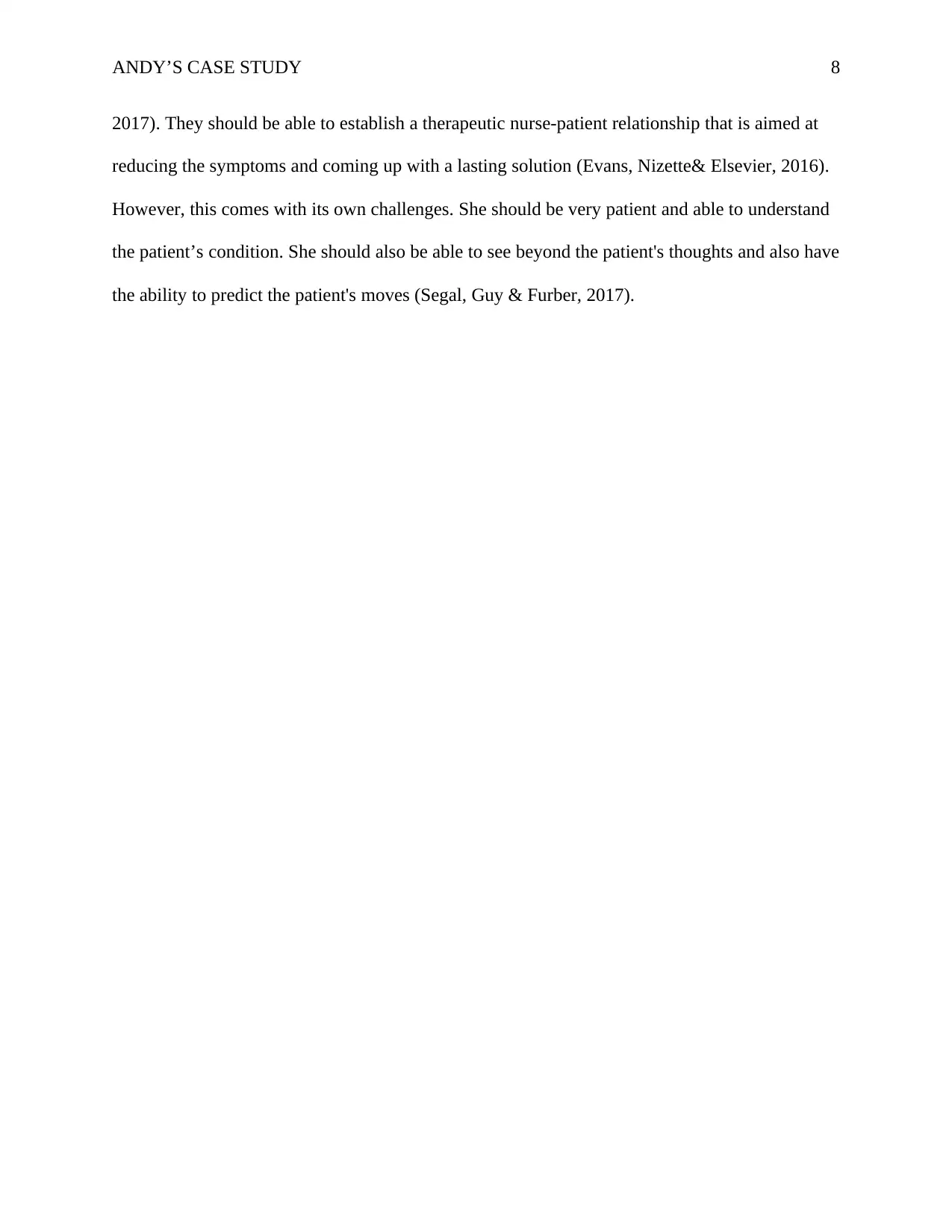
ANDY’S CASE STUDY 8
2017). They should be able to establish a therapeutic nurse-patient relationship that is aimed at
reducing the symptoms and coming up with a lasting solution (Evans, Nizette& Elsevier, 2016).
However, this comes with its own challenges. She should be very patient and able to understand
the patient’s condition. She should also be able to see beyond the patient's thoughts and also have
the ability to predict the patient's moves (Segal, Guy & Furber, 2017).
2017). They should be able to establish a therapeutic nurse-patient relationship that is aimed at
reducing the symptoms and coming up with a lasting solution (Evans, Nizette& Elsevier, 2016).
However, this comes with its own challenges. She should be very patient and able to understand
the patient’s condition. She should also be able to see beyond the patient's thoughts and also have
the ability to predict the patient's moves (Segal, Guy & Furber, 2017).
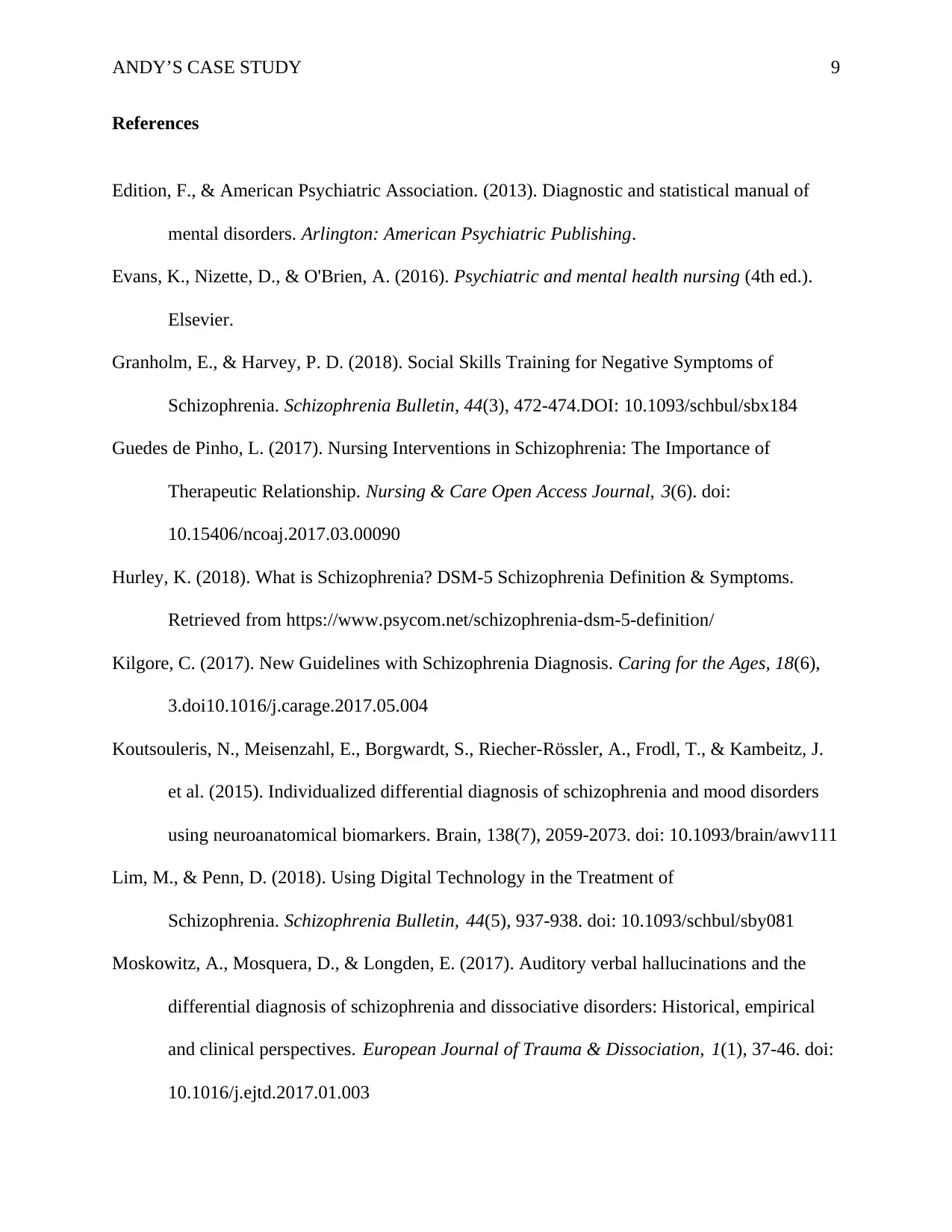
ANDY’S CASE STUDY 9
References
Edition, F., & American Psychiatric Association. (2013). Diagnostic and statistical manual of
mental disorders. Arlington: American Psychiatric Publishing.
Evans, K., Nizette, D., & O'Brien, A. (2016). Psychiatric and mental health nursing (4th ed.).
Elsevier.
Granholm, E., & Harvey, P. D. (2018). Social Skills Training for Negative Symptoms of
Schizophrenia. Schizophrenia Bulletin, 44(3), 472-474.DOI: 10.1093/schbul/sbx184
Guedes de Pinho, L. (2017). Nursing Interventions in Schizophrenia: The Importance of
Therapeutic Relationship. Nursing & Care Open Access Journal, 3(6). doi:
10.15406/ncoaj.2017.03.00090
Hurley, K. (2018). What is Schizophrenia? DSM-5 Schizophrenia Definition & Symptoms.
Retrieved from https://www.psycom.net/schizophrenia-dsm-5-definition/
Kilgore, C. (2017). New Guidelines with Schizophrenia Diagnosis. Caring for the Ages, 18(6),
3.doi10.1016/j.carage.2017.05.004
Koutsouleris, N., Meisenzahl, E., Borgwardt, S., Riecher-Rössler, A., Frodl, T., & Kambeitz, J.
et al. (2015). Individualized differential diagnosis of schizophrenia and mood disorders
using neuroanatomical biomarkers. Brain, 138(7), 2059-2073. doi: 10.1093/brain/awv111
Lim, M., & Penn, D. (2018). Using Digital Technology in the Treatment of
Schizophrenia. Schizophrenia Bulletin, 44(5), 937-938. doi: 10.1093/schbul/sby081
Moskowitz, A., Mosquera, D., & Longden, E. (2017). Auditory verbal hallucinations and the
differential diagnosis of schizophrenia and dissociative disorders: Historical, empirical
and clinical perspectives. European Journal of Trauma & Dissociation, 1(1), 37-46. doi:
10.1016/j.ejtd.2017.01.003
References
Edition, F., & American Psychiatric Association. (2013). Diagnostic and statistical manual of
mental disorders. Arlington: American Psychiatric Publishing.
Evans, K., Nizette, D., & O'Brien, A. (2016). Psychiatric and mental health nursing (4th ed.).
Elsevier.
Granholm, E., & Harvey, P. D. (2018). Social Skills Training for Negative Symptoms of
Schizophrenia. Schizophrenia Bulletin, 44(3), 472-474.DOI: 10.1093/schbul/sbx184
Guedes de Pinho, L. (2017). Nursing Interventions in Schizophrenia: The Importance of
Therapeutic Relationship. Nursing & Care Open Access Journal, 3(6). doi:
10.15406/ncoaj.2017.03.00090
Hurley, K. (2018). What is Schizophrenia? DSM-5 Schizophrenia Definition & Symptoms.
Retrieved from https://www.psycom.net/schizophrenia-dsm-5-definition/
Kilgore, C. (2017). New Guidelines with Schizophrenia Diagnosis. Caring for the Ages, 18(6),
3.doi10.1016/j.carage.2017.05.004
Koutsouleris, N., Meisenzahl, E., Borgwardt, S., Riecher-Rössler, A., Frodl, T., & Kambeitz, J.
et al. (2015). Individualized differential diagnosis of schizophrenia and mood disorders
using neuroanatomical biomarkers. Brain, 138(7), 2059-2073. doi: 10.1093/brain/awv111
Lim, M., & Penn, D. (2018). Using Digital Technology in the Treatment of
Schizophrenia. Schizophrenia Bulletin, 44(5), 937-938. doi: 10.1093/schbul/sby081
Moskowitz, A., Mosquera, D., & Longden, E. (2017). Auditory verbal hallucinations and the
differential diagnosis of schizophrenia and dissociative disorders: Historical, empirical
and clinical perspectives. European Journal of Trauma & Dissociation, 1(1), 37-46. doi:
10.1016/j.ejtd.2017.01.003
⊘ This is a preview!⊘
Do you want full access?
Subscribe today to unlock all pages.

Trusted by 1+ million students worldwide
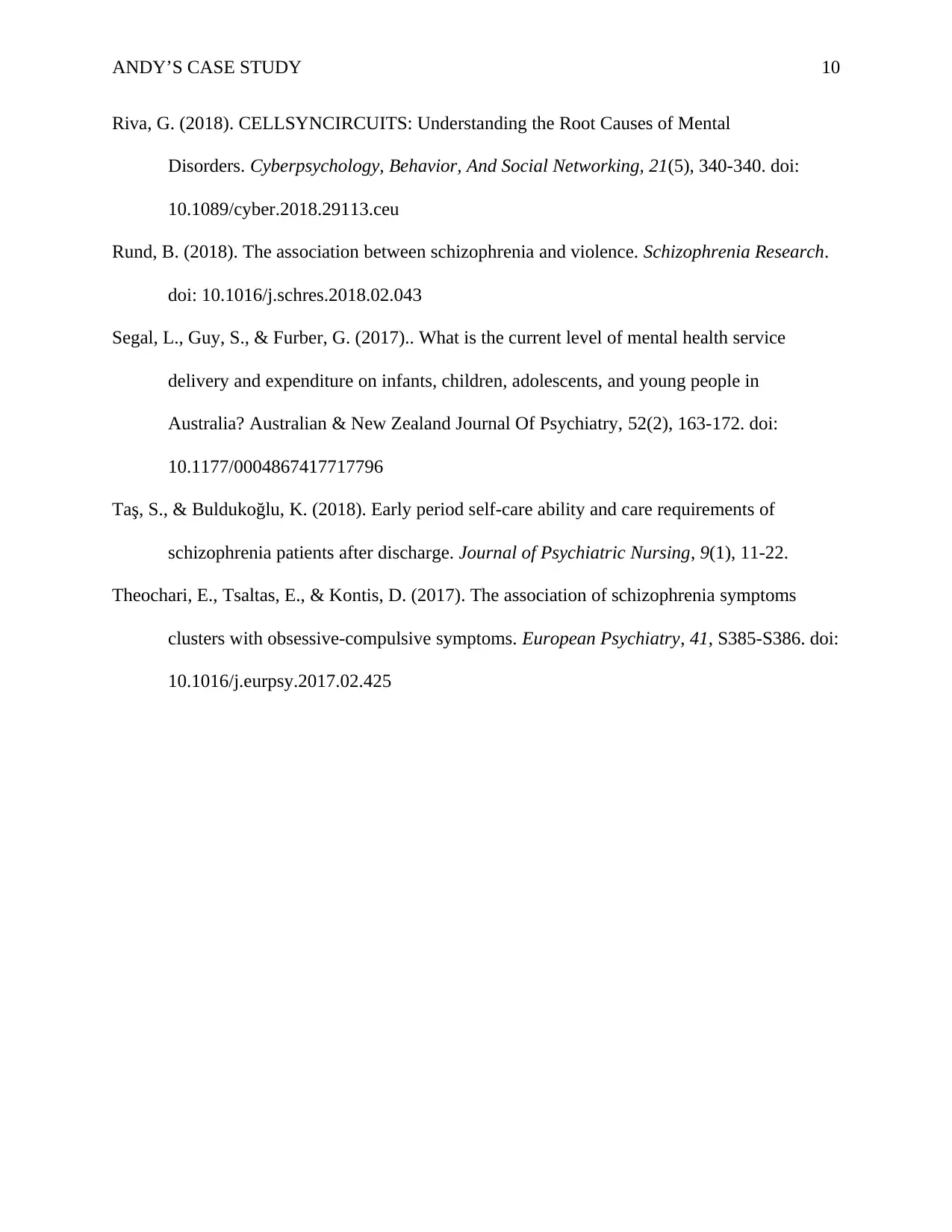
ANDY’S CASE STUDY 10
Riva, G. (2018). CELLSYNCIRCUITS: Understanding the Root Causes of Mental
Disorders. Cyberpsychology, Behavior, And Social Networking, 21(5), 340-340. doi:
10.1089/cyber.2018.29113.ceu
Rund, B. (2018). The association between schizophrenia and violence. Schizophrenia Research.
doi: 10.1016/j.schres.2018.02.043
Segal, L., Guy, S., & Furber, G. (2017).. What is the current level of mental health service
delivery and expenditure on infants, children, adolescents, and young people in
Australia? Australian & New Zealand Journal Of Psychiatry, 52(2), 163-172. doi:
10.1177/0004867417717796
Taş, S., & Buldukoğlu, K. (2018). Early period self-care ability and care requirements of
schizophrenia patients after discharge. Journal of Psychiatric Nursing, 9(1), 11-22.
Theochari, E., Tsaltas, E., & Kontis, D. (2017). The association of schizophrenia symptoms
clusters with obsessive-compulsive symptoms. European Psychiatry, 41, S385-S386. doi:
10.1016/j.eurpsy.2017.02.425
Riva, G. (2018). CELLSYNCIRCUITS: Understanding the Root Causes of Mental
Disorders. Cyberpsychology, Behavior, And Social Networking, 21(5), 340-340. doi:
10.1089/cyber.2018.29113.ceu
Rund, B. (2018). The association between schizophrenia and violence. Schizophrenia Research.
doi: 10.1016/j.schres.2018.02.043
Segal, L., Guy, S., & Furber, G. (2017).. What is the current level of mental health service
delivery and expenditure on infants, children, adolescents, and young people in
Australia? Australian & New Zealand Journal Of Psychiatry, 52(2), 163-172. doi:
10.1177/0004867417717796
Taş, S., & Buldukoğlu, K. (2018). Early period self-care ability and care requirements of
schizophrenia patients after discharge. Journal of Psychiatric Nursing, 9(1), 11-22.
Theochari, E., Tsaltas, E., & Kontis, D. (2017). The association of schizophrenia symptoms
clusters with obsessive-compulsive symptoms. European Psychiatry, 41, S385-S386. doi:
10.1016/j.eurpsy.2017.02.425
1 out of 10
Related Documents
Your All-in-One AI-Powered Toolkit for Academic Success.
+13062052269
info@desklib.com
Available 24*7 on WhatsApp / Email
![[object Object]](/_next/static/media/star-bottom.7253800d.svg)
Unlock your academic potential
Copyright © 2020–2025 A2Z Services. All Rights Reserved. Developed and managed by ZUCOL.





